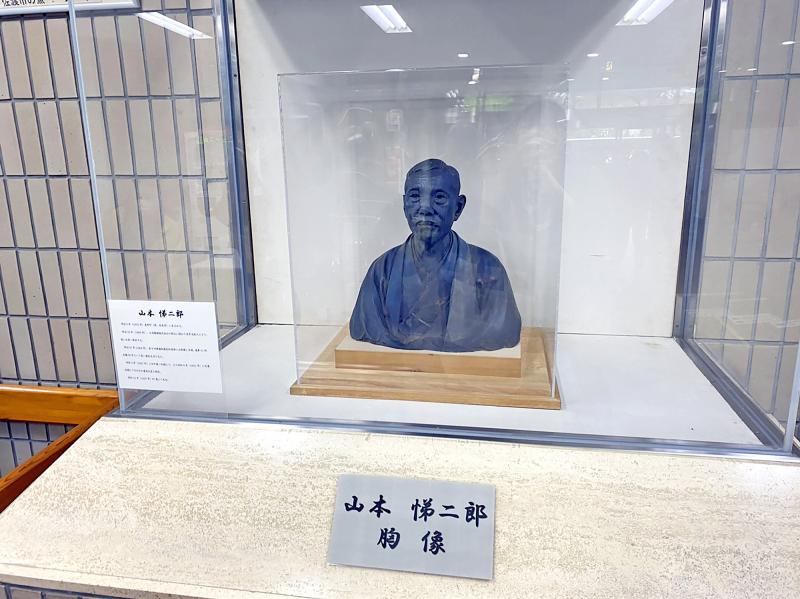A bust of early 20th-century Japanese politician Teijiro Yamamoto made by Taiwanese sculptor Huang Tu-shui (黃土水) is to be returned to Taiwan for restoration, in an agreement reached through Taiwan’s representative office in Tokyo.
Born in 1895, Huang was the first Taiwanese to study art in Japan during the Japanese colonial era, and became one of Japan’s most prominent artists until his death in 1930.
The plaster bust was one of his early works, which had been on display in Sado in Japan’s Niigata Prefecture.

Photo courtesy of Taipei Economic and Cultural Office in Japan via CNA
With the Taiwan Cultural Center in Tokyo acting as mediator, Taiwanese art enthusiast Chang Su-chen (張素真) and officials from the Ministry of Culture and the National Taiwan Museum of Fine Arts in May negotiated with the city to return the bust for restoration.
Chang is the son of long-term Sado resident Juo Lin-su (若林素), who founded a dance troupe in the city.
The bust is expected to arrive by the end of the year, after which the museum would begin its restoration, the museum said.
The museum would also make a reproduction of the bust, which would be added to its permanent collection, and the original would be returned to Sado, it said.
Another of Huang’s famous plaster works — Mountain Child Playing Flute (山童吹笛) — was included in the Japanese Imperial Exhibition of 1922.
Huang’s works often focused on his strong affection for Taiwan, and were popular with the Japanese emperor and affluent members of Japanese society.
Wang Shu-fang (王淑芳) of the Taiwan Cultural Center in Tokyo visited Sado on Friday last week to inspect the bust and meet with Sado Mayor Ryugo Watanabe.
Representative to Japan Frank Hsieh (謝長廷) thanked Sado officials for allowing the work to be brought back to Taiwan, and said that he anticipated future cooperation with the city on cultural and tourism exchanges.
Watanabe expressed admiration for the Ministry of Culture’s determination to restore the bust, and echoed Hsieh’s commitment to future cooperation.
Four of Huang’s busts stayed in Japan after his death, Wang said, citing Eka Suzuki, a Japanese researcher of art in colonial-era Taiwan.
Two of those works — one of Japanese bacteriologist Tomoe Takagi and one of influential Japanese businessman Kobei Abe — were previously donated to National Chang-Hua Senior High School.
The other two — both of Yamamoto, one made of plaster and the other of bronze — were in Sado.
The bronze sculpture had originally been installed near Kaohsiung Bridge, but was taken to Japan following World War II, Wang said.

SHIPS, TRAINS AND AUTOMOBILES: The ministry has announced changes to varied transportation industries taking effect soon, with a number of effects for passengers Beginning next month, the post office is canceling signature upon delivery and written inquiry services for international registered small packets in accordance with the new policy of the Universal Postal Union, the Ministry of Transportation and Communications said yesterday. The new policy does not apply to packets that are to be delivered to China, the ministry said. Senders of international registered small packets would receive a NT$10 rebate on postage if the packets are sent from Jan. 1 to March 31, it added. The ministry said that three other policies are also scheduled to take effect next month. International cruise ship operators

NUMBERS IMBALANCE: More than 4 million Taiwanese have visited China this year, while only about half a million Chinese have visited here Beijing has yet to respond to Taiwan’s requests for negotiation over matters related to the recovery of cross-strait tourism, the Tourism Administration said yesterday. Taiwan’s tourism authority issued the statement after Chinese-language daily the China Times reported yesterday that the government’s policy of banning group tours to China does not stop Taiwanese from visiting the country. As of October, more than 4.2 million had traveled to China this year, exceeding last year. Beijing estimated the number of Taiwanese tourists in China could reach 4.5 million this year. By contrast, only 500,000 Chinese tourists are expected in Taiwan, the report said. The report

The Forestry and Nature Conservation Agency yesterday launched a gift box to market honey “certified by a Formosan black bear” in appreciation of a beekeeper’s amicable interaction with a honey-thieving bear. Beekeeper Chih Ming-chen (池明鎮) in January inspected his bee farm in Hualien County’s Jhuosi Township (卓溪) and found that more than 20 beehives had been destroyed and many hives were eaten, with bear droppings and paw prints near the destroyed hives, the agency said. Chih returned to the farm to move the remaining beehives away that evening when he encountered a Formosan black bear only 20m away, the agency said. The bear

Chinese embassy staffers attempted to interrupt an award ceremony of an international tea competition in France when the organizer introduced Taiwan and displayed the Republic of China flag, a Taiwanese tea farmer said in an interview published today. Hsieh Chung-lin (謝忠霖), chief executive of Juxin Tea Factory from Taichung's Lishan (梨山) area, on Dec. 2 attended the Teas of the World International Contest held at the Peruvian embassy in Paris. Hsieh was awarded a special prize for his Huagang Snow Source Tea by the nonprofit Agency for the Valorization of Agricultural Products (AVPA). During the ceremony, two Chinese embassy staffers in attendance